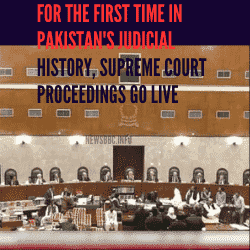In a historic moment in the annals of Pakistan’s judicial history, the full court of the Supreme Court, comprising all 15 judges, has granted permission for the live telecast of proceedings related to a set of petitions challenging the SC (Practice and Procedure) Act 2023. This contentious law seeks to regulate the suo motu powers of the Chief Justice of Pakistan (CJP) and has sparked significant debate and legal scrutiny.
Unprecedented Transparency:
Live Broadcast of Proceedings
Under the leadership of Chief Justice of Pakistan, Qaez Faez Isa, the full court of the Supreme Court is currently conducting hearings on the petitions, with the proceedings being broadcast live on the state television channel, PTV. This marks the first time in the nation’s judicial history that such a momentous decision has been taken to allow the public to witness court proceedings in real-time.
Admissibility and the Decision to Convene a Full Court
The apex court, in a pivotal move, declared the petitions seeking a full court hearing on the matter as admissible. CJP Isa emphasized that the decision to hold a full court hearing was made during a full court meeting. This decision underscores the significance and complexity of the issues at hand.
Fresh Beginnings:
New Bench for the Case in Pakistan’s judicial history
During the hearing, Chief Justice Isa announced that the arguments in the case would commence afresh, as a new bench had been constituted for this purpose. This development emphasizes the gravity of the petitions challenging the SC (Practice and Procedure) Act 2023.
Attorney General’s Response:
Seeking Rejection of Petitions
Prior to the hearing, the Attorney General for Pakistan, Mansoor Usman Awan, submitted the federal government’s response to the matter. The government’s stance is clear: it seeks the rejection of the petitions against the Supreme Court Practice and Procedure Act. The government contends that petitions against acts of parliament are inadmissible, highlighting the core of their argument.
Rigorous Preparations for Live Broadcast of Pakistan’s judicial history
In preparation for the historic live broadcast, meticulous arrangements were made within the courtroom. A total of five cameras were installed to capture various angles of the proceedings. Four cameras were strategically placed in the visitors’ gallery, providing a comprehensive view of the courtroom, while one camera was designated for the lawyers’ rostrum, situated in front of the judges’ docks.
The Composition of the Full Court of Pakistan’s judicial history
The full court, convened by the newly-appointed Chief Justice of Pakistan, Qazi Faez Isa, comprises esteemed judges of the Supreme Court. These distinguished justices include Justice Sardar Tariq Masood, Justice Ijazul Ahsan, Justice Syed Mansoor Ali Shah, Justice Munib Akhtar, Justice Yahya Afridi, Justice Aminuddin Khan, Justice Sayyed Mazahar Ali Akbar Naqvi, Justice Jamal Khan Mandokhel, Justice Muhammad Ali Mazhar, Justice Ayesha A. Malik, Justice Athar Minallah, Justice Syed Hasan Azhar Rizvi, Justice Shahid Waheed, and Justice Musarrat Hilali.
The Decision for Live Broadcast: A Product of Deliberation
Prior to the momentous decision to broadcast the proceedings live, a full court meeting was convened to contemplate the guidelines and modalities for ensuring the effectiveness of the hearing. It is worth noting that this decision was swiftly implemented, coming into effect shortly after Chief Justice Isa assumed office.
A Commitment to Accessible Justice
Upon his arrival at the Supreme Court, Chief Justice Isa emphasized the importance of treating visitors to the court as guests. He reiterated that the doors to justice should always remain open, underscoring his commitment to accessible justice for all.
The Proceedings Pakistan’s judicial history:
A Fresh Start
The hearing commenced with Chief Justice Isa acknowledging the existence of nine applications, prompting Advocate Khawaja Tariq Rahim to initiate his arguments. The CJP urged Rahim to delve into the Act and approach the case with a fresh perspective, leaving past proceedings aside.
Key Questions Arise from Pakistan’s judicial history
As the proceedings unfolded, pivotal questions regarding the Act’s implications emerged. Justice Ayesha inquired about the effect of Section 5, which grants the right of appeal, should the law be upheld. Advocate Rahim referred to the practice act and pointed out Parliament’s role in forming a committee of judges to decide on matters of public interest, invoking Article 191 of the Constitution.
Deliberations on Parliament’s Authority
The debate in the courtroom delved into the realm of Parliament’s authority. Justice Mandokhail raised the fundamental question of whether Parliament had the power to nullify the chief justice’s authority through legislation. Justice Athar, inquisitive about the limitations on forming benches, questioned whether an unchecked power vested in the chief justice was desirable.
A Plethora of Questions
A multitude of pertinent questions emerged during the proceedings, challenging the constitutionality and impact of the Act. The CJP, displaying patience and wisdom, urged Advocate Rahim to meticulously record these questions and address them comprehensively at a later stage. The judges’ collective wisdom was instrumental in probing the nuances of the law.
Also visit:Grant Shapps Appointed as Defence Secretary A Defining Moment in UK Politics
Focusing on Legal Arguments
Throughout the hearing, Chief Justice Isa repeatedly steered the proceedings back to the legal aspects of the case. He discouraged the insertion of “personal opinions” and encouraged a rigorous focus on the legal framework. This insistence on the rule of law underscored the seriousness of the matter.
The Role of Parliament in Pakistan’s judicial history
Advocate Rahim contended that Parliament had, in essence, interfered with the established rules of the Supreme Court. The discussion turned to the boundaries of parliamentary authority, prompting reflections on whether Parliament could enact such legislation.
Chief Justice’s Perspective: A Humble Approach
Amidst the legal debate, Chief Justice Isa shared his perspective, emphasizing that he did not seek absolute authority. He articulated that as the chief justice, he was committed to upholding the law and the Constitution, rather than wielding unchecked power. He cited examples of past court decisions that had far-reaching financial consequences, highlighting the importance of responsible decision-making.
The Government’s Stand of Pakistan’s judicial history:
Law in the Public Interest
After a brief recess, Attorney General Mansoor Usman Awan presented the government’s viewpoint. He argued that the Act in question did not curtail the powers of the entire judiciary but rather focused on the powers of one office—the chief justice. He contended that the law aimed to introduce “democratic transparency” to the institution and was in the public interest.
The Path Forward to Pakistan’s judicial history
The legal proceedings surrounding the SC (Practice and Procedure) Act 2023 have set the stage for significant deliberation and debate. As the full court rigorously examines the implications of this law, the nation watches with keen interest. The quest for a balance between judicial authority and democratic transparency remains at the forefront of this historic legal endeavor.

